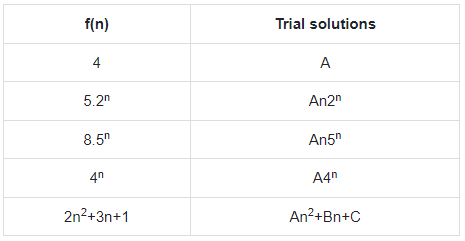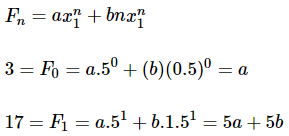Recurrence Relations | Engineering Mathematics - Engineering Mathematics PDF Download
Introduction
A recurrence relation is an equation that recursively defines a sequence where the next term is a function of the previous terms (Expressing Fn as some combination of Fi with i < n).
Example − Fibonacci series − Fn = Fn−1 + Fn−2, Tower of Hanoi − Fn = 2Fn−1 + 1
Linear Recurrence Relations
A linear recurrence equation of degree k or order k is a recurrence equation which is in the format xn = A1xn−1 + A2xn−1 + A3xn−1 +…Akxn−k (An is a constant and Ak ≠ 0) on a sequence of numbers as a first-degree polynomial.
These are some examples of linear recurrence equations −
 How to solve linear recurrence relation
How to solve linear recurrence relation
Suppose, a two ordered linear recurrence relation is − Fn = AFn−1 + BFn−2 where A and B are real numbers.
The characteristic equation for the above recurrence relation is −
x2 − Ax − B = 0
Three cases may occur while finding the roots −
- Case 1 − If this equation factors as (x − x1)(x − x1) = 0 and it produces two distinct real roots x1 and x2, then Fn =
 is the solution. [Here, a and b are constants]
is the solution. [Here, a and b are constants] - Case 2 − If this equation factors as (x - x1)2 = 0 and it produces single real root x1, then Fn =
 is the solution.
is the solution. - Case 3 − If the equation produces two distinct complex roots, x1 and x2 in polar form x1 = r ∠ θ and x2 = r∠(−θ), then Fn = rn(acos(nθ) + bsin(nθ)) is the solution.
Problem 1: Solve the recurrence relation Fn = 5Fn−1 − 6Fn−2 where F0 = 1 and F1 = 4
The characteristic equation of the recurrence relation is −
x2 − 5x + 6 = 0,
So, (x−3)(x−2)=0
Hence, the roots are −
x1 = 3 and x2 = 2
The roots are real and distinct. So, this is in the form of case 1
Hence, the solution is −
Here, Fn = a3n + b2n (As x1 = 3 and x2 = 2)Therefore,
1 = F0 = a30 + b20 = a + b
4 = F1 = a31 + b21 = 3a + 2bSolving these two equations, we get a = 2 and b = −1
Hence, the final solution is −
Fn = 2.3n + (−1).2n = 2.3n − 2n
Problem 2: Solve the recurrence relation − Fn = 10Fn−1−25Fn−2 where F0 = 3 and F1 = 17
The characteristic equation of the recurrence relation is −
x2 − 10x − 25 = 0
So (x−5)2 = 0Hence, there is single real root x1 = 5
As there is single real valued root, this is in the form of case 2
Hence, the solution is −
Solving these two equations, we get a = 3 and b = 2/5
Hence, the final solution is − Fn = 3.5n + (2/5).n.2n
Problem 3: Solve the recurrence relation Fn = 2Fn−1−2Fn−2 where F0 = 1 and F1 = 3
The characteristic equation of the recurrence relation is −
x2 − 2x − 2 = 0Hence, the roots are −
x1 = 1 + i and x2 = 1 − i
In polar form,
x1 = r∠θ and x2 = r∠(−θ), where r = √2 and θ = π/4
The roots are imaginary. So, this is in the form of case 3.
Hence, the solution is −
Fn = (2–√)n(acos(n.⊓/4) + bsin(n.⊓/4))1 = F0 = (2–√)0(acos(0.⊓/4)+bsin(0.⊓/4)) = a
3 = F1 = (2–√)1(acos(1.⊓/4) + bsin(1.⊓/4)) = 2–√(a/2–√ + b/2–√)
Solving these two equations we get a=1 and b=2
Hence, the final solution is −
Fn = (√2)n(cos(n.π/4)+2sin(n.π/4))
Non-Homogeneous Recurrence Relation and Particular Solutions
A recurrence relation is called non-homogeneous if it is in the form
Fn = AFn−1 + BFn−2 + f(n) where f(n) ≠ 0
Its associated homogeneous recurrence relation is Fn = AFn–1 + BFn−2
The solution (an) of a non-homogeneous recurrence relation has two parts.
First part is the solution (ah) of the associated homogeneous recurrence relation and the second part is the particular solution (at).
an = ah + at
Solution to the first part is done using the procedures discussed in the previous section.
To find the particular solution, we find an appropriate trial solution.
Let f(n) = cxn ; let x2 = Ax+B be the characteristic equation of the associated homogeneous recurrence relation and let x1 and x2 be its roots.
If x ≠ x1 and x ≠ x2, then at = Axn
If x = x1, x ≠ x2, then at = Anxn
If x = x1 = x2, then at = An2xn
Example
Let a non-homogeneous recurrence relation be Fn = AFn–1 + BFn−2 + f(n) with characteristic roots x1 = 2 and x2 = 5. Trial solutions for different possible values of f(n) are as follows −

Problem: Solve the recurrence relation Fn = 3Fn−1 + 10Fn−2 + 7.5n where F0 = 4 and F1 = 3
This is a linear non-homogeneous relation, where the associated homogeneous equation is Fn = 3Fn−1 + 10Fn−2 and f(n) = 7.5n
The characteristic equation of its associated homogeneous relation is −
x2 − 3x − 10 = 0
Or, (x − 5)(x + 2) = 0
Or, x1 = 5 and x2 = −2
Hence ah = a.5n + b.(−2)n , where a and b are constants.
Since f(n) = 7.5n, i.e. of the form c.xn, a reasonable trial solution of at will be Anxn
at = Anxn = An5n
After putting the solution in the recurrence relation, we get −
An5n = 3A(n–1)5n−1 + 10A(n–2)5n−2 + 7.5nDividing both sides by 5n−2, we get
An52 = 3A(n−1)5 + 10A(n−2)50 + 7.52Or, 25An = 15An − 15A + 10An − 20A + 175
Or, 35A = 175
Or, A = 5
So, Fn = An5n = 5n5n = n5n+1
The solution of the recurrence relation can be written as −
Fn = ah + at
= a.5n + b.(−2)n + n5n + 1Putting values of F0 = 4 and F1 = 3, in the above equation, we get a = −2 and b = 6
Hence, the solution is −
Fn = n5n+1 + 6.(−2)n−2.5n
Generating Functions
Generating Functions represents sequences where each term of a sequence is expressed as a coefficient of a variable x in a formal power series.
Mathematically, for an infinite sequence, say a0, a1, a2,…,ak,…, the generating function will be −

Some Areas of Application
Generating functions can be used for the following purposes −
- For solving a variety of counting problems. For example, the number of ways to make change for a Rs. 100 note with the notes of denominations Rs.1, Rs.2, Rs.5, Rs.10, Rs.20 and Rs.50
- For solving recurrence relations
- For proving some of the combinatorial identities
- For finding asymptotic formulae for terms of sequences
Problem 1: What are the generating functions for the sequences {ak} with ak = 2 and ak = 3k?
When ak = 2, generating function,
When
Problem 2: What is the generating function of the infinite series; 1,1,1,1,…?
Here, ak = 1, for 0 ≤ k ≤ ∞
Hence, G(x) = 1 + x + x2 + x3 +…⋯ = 1/(1−x)Some Useful Generating Functions
For ak=ak,G(x)=∑∞k=0akxk=1+ax+a2x2+……⋯=1/(1−ax)
For ak=(k+1),G(x)=∑∞k=0(k+1)xk=1+2x+3x2……⋯=1(1−x)2
For ak=cnk,G(x)=∑∞k=0cnkxk=1+cn1x+cn2x2+……⋯+x2=(1+x)n
For ak=1k!,G(x)=∑∞k=0xkk!=1+x+x22!+x33!……⋯=ex
|
65 videos|129 docs|94 tests
|





















